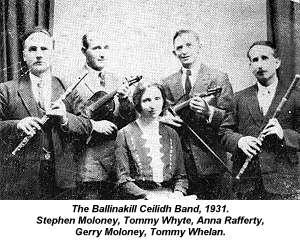 Again, it was the daughter whom Lucy knew best and played music with. It was, of course, the Moloney and Whelan families who later formed the nucleus of the Ballinakill Traditional Dance Players.
Again, it was the daughter whom Lucy knew best and played music with. It was, of course, the Moloney and Whelan families who later formed the nucleus of the Ballinakill Traditional Dance Players.
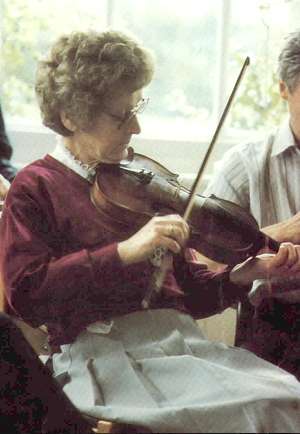 "No way", says Lucy, "could I do it." The fiddle, which had but two gut strings, was kept above the kitchen fire and when aunt Margaret eventually married it was left in Lucy's care. She still has it but has always found it, somehow, cramped to her fingers .
"No way", says Lucy, "could I do it." The fiddle, which had but two gut strings, was kept above the kitchen fire and when aunt Margaret eventually married it was left in Lucy's care. She still has it but has always found it, somehow, cramped to her fingers .
Lucy's father, she says, was a quiet, self-contained man who rarely offered immediate comment on music but would keep his observations until later. Then he might point out a felicitous run or phrase and suggest where a note might be changed - an instinctive response, it would seem, born out of long acquaintance with the music. He was also firm: once, Lucy remembers, he listened to her attempts to join in a session and, after the other players had gone, told her simply never to play along in such circumstances again unless she truly knew the music because, whatever they might say, it could put the musicians off their stroke.
Apart from her father, only her brother (also Martin) of the immediate family played in any regular fashion - a flute - and Lucy thinks that this was, in any case, after she herself started to play seriously and that would have been when she was around twelve years of age.
Mostly the family sang, the children being encouraged to do so in front of visitors, usually aunts and uncles and other more distant members of the family. Otherwise, Lucy says, she was much more interested in dancing and in the nightly story-telling, especially that of her grandfather. To his annoyance, the children often mischievously interrupted and anticipated a favourite punch-line or maxim.
There is, then, little that is remarkable in this upbringing, except that music was a vital part of family life, not marginalised. Importantly, Martin Kirwan's farm was one of two venues where people met to play and catch up on news. The other house was that of Stephen Moloney who played flute "and also played the bagpipes, his son Jim and myself played a bit together ... The other Moloney boys were younger than me ..." Jim played flute, so did Ambrose, and Eddie flute and whistle. However, it was Alice whom Lucy knew best and they sometimes sang together.
The Whelan family, from "down the road", also visited the Moloney house: Tommy, a flute-player and friend of Stephen's and Tommy' s daughter, Kathleen, who played fiddle.  Again, it was the daughter whom Lucy knew best and played music with. It was, of course, the Moloney and Whelan families who later formed the nucleus of the Ballinakill Traditional Dance Players.
Again, it was the daughter whom Lucy knew best and played music with. It was, of course, the Moloney and Whelan families who later formed the nucleus of the Ballinakill Traditional Dance Players.
House-visiting of this kind was frequent but confined to the near neighbourhood since transport was not easily available and Lucy and her sisters were not allowed to roam far. Obviously, as far as the music itself is concerned, this regular contact between musicians (and, indeed, the particular instruments that dominated) were factors in the development of a close-knit way of playing (but see below: 'Style and Repertoire').
Incidentally, there were rarely any uilleann pipes, although Leo Rowsome visited the Moloneys once or twice and Lucy then heard the pipes for the first time. She does remember sitting on a row of slabs just outside the family farm gate, hearing the sound of Stephen Moloney's bagpipes - war-pipes, they are often called - spreading through the meadows.
There was a second factor in Lucy's musical experience: attendance at dances - some held in the family home where, for example, they started at eight o'clock (usually weekly) "and it was a case of Round the House in eight-hand sets (Quadrilles) and Mind the Dresser". The kitchen was not big enough for full sets. There was no drink except tea. Of course, Lucy and her friends spent time wondering which likely lad might turn up "for a little legal courting under the watchful eye of my father'." There were also dances held at nearby schools, following much the same pattern; and flag dances held at crossroads in the neighbourhood: Lalor's, Aille and down in Leitrim. Baulks of wood were staked in place on three sides of a square for the musicians to sit on. Then, at the autumn 'thrashings', because it was the custom to visit and help out, the company would finish the night dancing. Music at the housedances was nearly always provided by flutes and fiddles and a bodhran (played regularly by 'Barrel' Rafferty). One time, Lucy remembers no less than eleven flute players in full flow.
Collectively, then, the local dances and meeting-up at houses provided the substance of Lucy's earliest musical education. Eventually, though, in circumstances which still evoke great bitterness amongst people, the clergy put a stop to house-dancing in order that occasions of sin might not arise. "It was known that at the end of a dance a priest would go out with a walking stick looking for courting couples and put the fear of God into them if he could find them." At the time, Lucy concedes, youngsters were much more interested in meeting and playing music. She herself had left home before the Dance Hall Act took effect in the mid-1930s.
One of the highlights of the year was the Mummers' Dance. A group of lads would tour the district with their music, visiting various houses where they would play and dance a step and receive money in return.
Lucy once overheard her brother admonishing the Mummers at a particular house where it was known that a good response might be had. A favourite tune, The Collier's Reel, was to be played and Lucy's brother Martin said: "Let ye play it middlin' good." Afterwards, Martin was suitably amazed when Lucy, who should not have been around at all, asked if the boys had, indeed, played "middlin' good". The Mummers were always male and Lucy had never travelled with them.
At Baunyknave, where the Mummers fetched up, Martin Kirwan senior was most particular. At the time, all over Ireland, it was quite normal for a kitchen floor to be flagged and for one flagstone at the hearth to be special, laid on hollows and foundations which made it especially suitable for stepping. Lucy recalls that at Baunyknave this flag was actually outside the house and was crossed with great respect - "who knew what spirits good or evil were lurking underneath it?" This kind of belief seems to have been typical: the kitchen fire, for example, must never be allowed to go out or bad luck would ensue. The floor of the barn had to be most carefully prepared for the Mummers' Dance. It was sprung - that in itself was an expensive business and "a lot of strange things went under that floor" - blessed ashes kept from the previous Ash Wednesday, a rabbit's foot, some horsehair, and, in order that the priest could bless the barn, some holy water. The barn was lit by candles, four to each of two sconces. Seating for the musicians was on bags of wheat and oats arranged on boards which were themselves laid across grain bins, "the width of the barn." The ladies brought in home-made sweet-cake and the men paid for half a barrel of porter, drunk from enamel mugs, never precious heirloom glasses. Lucy and her sisters once arranged the legend, Cead Mile Failte, made up from laurel leaves gathered in the garden and attached to a white linen sheet - her mother's sacrifice.
During the evening there were always full sets of five figures and after each set a Round Polka when you "changed partners after every few bars of music ... until you had danced with everyone in the set." Lucy will promptly demonstrate the Round Polka, and her cassette tape, Heart and Home, includes a tune played for that figure. 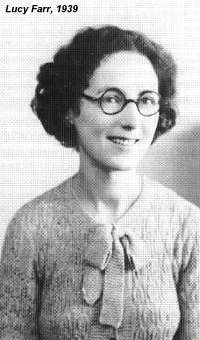 There were also barn-dances, two-steps and waltzes (mainly to song-tunes). Lucy recalls her aunt Margaret and a neighbour dancing The Varsovienne. Lucy's own job was to soak the flutes and she remembers getting into trouble because she used water from one of two pails set aside for her father's morning tea rather than the one used for general purposes. Her mother found parts of flutes left overnight.
There were also barn-dances, two-steps and waltzes (mainly to song-tunes). Lucy recalls her aunt Margaret and a neighbour dancing The Varsovienne. Lucy's own job was to soak the flutes and she remembers getting into trouble because she used water from one of two pails set aside for her father's morning tea rather than the one used for general purposes. Her mother found parts of flutes left overnight.
Lucy's actual schooling provided a supplement to these activities. She was taught tonic sol-fa by a Mrs O'Connell at the nearby school at Duniry (not Ballinakill; and the lessons were extra ones) and how to pitch notes and how to play the piano. Later, Jack Mulkere, from Kiltartan, cycled over to give lessons at the National School in Ballinakill and Lucy learned musical notation. Jack also helped her with the fiddle - Lucy remembers being fearful that the family could not afford the pound a term but Martin Kirwan was pleased to stump up. She stayed with Jack Mulkere for a time but, in the end, and with no suggestion of ingratitude, felt that her own sense of traditional music was taking her beyond what was on offer ... so the lessons stopped. The family owned a gramophone which the sisters would play far into the night with socks stuffed into the bell, but there was no traditional music available on record.
It was the fiddle that had grabbed Lucy's attention and, amongst neighbours, Paddy Doorey was one of the first to encourage her. Neither he nor Jack Mulkere ever attempted to tell her how to hold the fiddle or the bow and, seeing that she was able to manage in her own way, were content to offer tunes, playing companionship and the necessary patience. In the end, Lucy got a fiddle of her own through the offices of a neighbour who, on a trip to Dublin, secured the instrument for a pound. The aunt's fiddle was hung up above the fire again.
Lucy recalls dances at the nearby Leitrim school with affection. Here, Paddy Doorey played, along with Mike Downey (fiddle), Tamsie Quinane (fiddle), Neilus Larkin - 'Neily' - (fiddle), Son Donnelly (flute) (who also played "regularly at our house") and Kathleen Whelan. Thomas Conroy was the first accordion player Lucy heard. Joe Hogan played whistle and flute; his brother, Micky, sang. Jack Coughlan played flute, as did Sonny Comer who later married Lucy's first cousin. His family, Lucy says, was full of dancers and one of his tunes may be heard on Heart and Home. Melodeons featured at the dances as well. Apart from Kathleen Whelan, Lucy does not remember any other of the family coming down to Leitrim, nor yet the Moloneys. Nor, incidentally, did Aggie Whyte or her father, Tommy, who lived a little nearer to Woodford.
It is, in some ways, curious that Lucy and Aggie have no real mutual background in music - they never played together on a regular basis in Ballinakill because each inhabited a slightly different social and musical circle. They never, therefore, cultivated the intimacies of one way of playing music. Subsequently, too, their paths crossed but briefly over the years. It is important to make this clear when considering style and repertoire in particular. The Ballinakill Players, for instance, were, it seems, brought together as a brainchild of Father Larkin and, as an entity, were never part of the day-to-day musical goings-on in the Ballinakill area. Similarly, as far as any putative 'placing' of this or that player is concerned, Lucy is adamant that, in her young days, there were no such 'critics'. You knew well if you did or did not play well, but were always received with the utmost politeness and encouragement. Music, as indicated above, was valued for its social cohesion.
This was the pattern of music-making, then, which dominated Lucy's childhood and teens. It is given some poignancy when it is realised that she knew nothing of, say, Joe Cooley, Paddy Carthy, the Coens or the Brodericks, all of whom lived but a few miles distant. The pattern was broken on the death of Lucy's father in 1932 when the house at Baunyknave ceased to act as a musical venue (being succeeded by that of the McCormicks nearby). Lucy and one of her sisters went to Mayo to work in 1933 and thence to England, and there was a hiatus in her playing for some fifteen years.
It is in fact, hard to grasp quite the full extent of Lucy's feelings during this extended interim period, deprived as she was of such an important facet of her life in both social and musical terms. Tom Flanagan, at any rate, had been connected with the engineering and building trades and several expatriate Irishmen had lodged with himself and Anne. Through these connections Anne had come to know that music was being played in the London area.
There was, it should be remembered, a tremendous influx of Irish people into England in search of work during the 1940s and '50s. 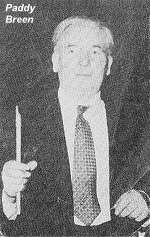 Sure enough, Paddy Breen, flute player from Clare, and Martin Mullen, from Galway, who played the box, were found at the Duke of Gloucester, just off Walworth Road, and Lucy became a regular Saturday night visitor. Sometimes, Paddy's two daughters, much to Lucy's delight, would dance a step. She also recalls sitting in with Paddy and Martin and being so excited as to fly into the tunes, only to be restrained by a fierce dig in the ribs from Paddy who urged her to take things easy, difficult after such a long absence from the music. It was Paddy Breen who, on another occasion, and typically it seems, insisted that a whole group of them on their way to a session should take out their instruments on London Bridge station. A crowd accumulated and, needless to say, the train was missed. The ice had been broken and Lucy became acquainted with several pub venues over a period of time.
Sure enough, Paddy Breen, flute player from Clare, and Martin Mullen, from Galway, who played the box, were found at the Duke of Gloucester, just off Walworth Road, and Lucy became a regular Saturday night visitor. Sometimes, Paddy's two daughters, much to Lucy's delight, would dance a step. She also recalls sitting in with Paddy and Martin and being so excited as to fly into the tunes, only to be restrained by a fierce dig in the ribs from Paddy who urged her to take things easy, difficult after such a long absence from the music. It was Paddy Breen who, on another occasion, and typically it seems, insisted that a whole group of them on their way to a session should take out their instruments on London Bridge station. A crowd accumulated and, needless to say, the train was missed. The ice had been broken and Lucy became acquainted with several pub venues over a period of time.
The birth of Comhaltas Ceoltóirí Éireann in the early 1950s also provided a stimulus. (Lucy, in common with numbers of Irish people, calls it 'Ce-ol-tas') A branch had been formed in West London with such luminaries as Paddy Taylor and Denis Doody involved, and it met first at The King's Head and then at The Greyhound. When another branch was formed in south London, meeting at The London and Brighton near to Lucy' s home in Ladywell, she found herself doing a seven-year committee stint with such as Johnny Hynes and Gerry Harrington. Activity was varied and a blow-by-blow account would be impossible, just as it would be of the pub scene. Lucy is, nevertheless, at pains to stress the impact Comhaltas made on her and speaks fondly of several members, notably the Judge family who were particularly generous towards her. At this remove, there was, perhaps, one surprising aspect: none of the formal teaching that is now taken for granted, until Tommy Maguire offered his services well into the '60s.
For Lucy, the next highpoint was the visit, around 1960, of the Leitrim Ceilidh Band, when Anne introduced and re-introduced her to its members. It was, in the end, a mortifying experience when Lucy, playing alongside Ambrose Moloney whose house she had so often frequented, found herself unable to integrate into the music. At least, though, she made lifelong friends of Paddy Carthy and Tony Molloy, and the encounter gave a great spur to her practising, which, according to the family, drove them all out of sleep and into madness. Then Lucy acquired another fiddle. She and Eric went on holiday in Kent, hired a fiddle so as to be able to play at a social function, liked it and bought it for £7. Again it is important to note the relatively sporadic nature of these developments so as to understand the kinds of frustrations that Lucy (and, no doubt, others) endured over the years. Lucy, at this time, was never at the centre of any kind of mainstream movement, particular session or pub scene.
Nonetheless as the family grew and, thanks to a helpful mother-in-law, Lucy was able to visit hotbeds of Irish music in London, although without a regular base of her own. In north London, pubs such as The Blackrap, The Laurel Tree and The Bedford Arms all hosted music. Lucy found her way to The Bedford where, during the years between 1955 and 1959, Michael Gorman and Margaret Barry were something of a focal point. Jimmy Power and The Rakes - who grouped formally in 1956 - were also prominent. 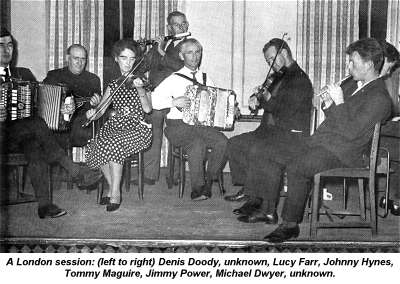 Thus, Lucy came to be introduced to a wider range of music. She recalls that Gorman, like Paddy Breen before him, was not above interfering in her playing, coolly adjusting the bridge on her fiddle in order to obtain greater volume. This was probably around 1959 - it was not for a year that Lucy became a regular at The Bedford.
Thus, Lucy came to be introduced to a wider range of music. She recalls that Gorman, like Paddy Breen before him, was not above interfering in her playing, coolly adjusting the bridge on her fiddle in order to obtain greater volume. This was probably around 1959 - it was not for a year that Lucy became a regular at The Bedford.
Out of the association of musicians at The Bedford came The Four Courts Ceilidh Band, with Jimmy Power and Paul Gross on fiddles, Michael Plunkett on flute, Tommy Maguire on accordion and Reg Hall on piano. Lucy eventually joined in 1963 along with Johnny Gorman (flute), later Benny O' Connor (drums) and other casual members. The band played at dance halls, parish and Comhaltas concerts, at Gaelic League ceilidhe, at The Singers Cub, on the radio, at church functions and at The Palladium. This kind of exposure was new to Lucy and she is still grateful for the years working in band contexts and the confidence that this brought her, though it must be said that the music did not, perhaps, represent her innermost feelings.
During these years there was a revival of Gaelic League activity and Lucy won a duet competition with a distant cousin, Johnny Forde (on flute), and a singing competition where she sang, among other songs, The Bonny Labouring Boy. This was at a feis in Eltham which she cannot date - and that inability is itself indicative of the comparative lack of interest that Lucy had and has in competitions. Once more, we are brought back to that strong element of social value that is more important. At that Eltham feis, though, Lucy was urged to listen to a fiddler playing The Wheels of the World. The fiddler was Bobby Casey. 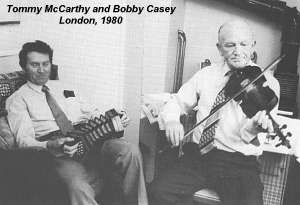 Lucy lilts the tune effortlessly. Bobby, she says, made a tremendous impression on her musical sense. She remembers asking Reg Hall about him, saying that she had heard that Bobby played at a venue called Casey's Altar - it transpired that this was the pub, The Case is Altered! Taking into account Bobby Casey's standing amongst musicians, Lucy's designation might not have been so far from the truth.
Lucy lilts the tune effortlessly. Bobby, she says, made a tremendous impression on her musical sense. She remembers asking Reg Hall about him, saying that she had heard that Bobby played at a venue called Casey's Altar - it transpired that this was the pub, The Case is Altered! Taking into account Bobby Casey's standing amongst musicians, Lucy's designation might not have been so far from the truth.
Perhaps the most significant event of these years took place in 1965 when Lucy visited her sister, Agnes, in Loughrea. She had returned to Ireland on several occasions and had, of course, corresponded with the family. Around Ballinakill, however, she had found it difficult to integrate easily with newer musicians (though this was one of the few occasions when she was able to renew acquaintance with Aggie Whyte) . The very first night in Moylan's in Loughrea brought her into the company of Paddy Carthy, Tony Molloy and John Joe Forde. When, eventually, the company barrelled off to Agnes' house, minus John Joe, Paddy Fahy followed after. Lucy had her first tape recorder and the music from these sessions survives. She found herself immediately at home with the music and for 20 years returned to the same group of musicians and the same venues. When Lucy refers to 'the old days' (and she could choose from any decade between 1920 and 1980) it is most often this period of time that she is invoking. A great deal of her favourite music comes from this source.
Overall, two main strands to her playing emerge. The first tends to represent the London conglomerate, the years spent playing in pub sessions, during Comhaltas activity and then with bands, and, as would be expected, is multifarious in character. The second strand is essentially Lucy's 'own', that music which appealed to her closest feelings, largely influenced by her initial musical upbringing and stimulated by contact with the players she found in Loughrea. It is not that the two elements necessarily fight but the London strand inevitably demonstrates the standard, the popular and the fashionable and something of a compromise in the way that the tunes were played. Given the opportunity to play on her own, despite protestations and some self-doubt, Lucy will almost always go for the tunes from the second strand. (This issue is further explored in section three.)
Lucy continued to be involved in sessions throughout the 1960s and '70s at The Favourite - though not that often - at the Irish Centre and at O' Malley's pub in King's Cross. She met Julia and John Clifford in pubs near the Angel. Her formal connections with Comhaltas lapsed, though she does remember a third place in a fiddle duet competition and she did travel to English fleadhanna with her husband. She also continued to play with The Rakes. 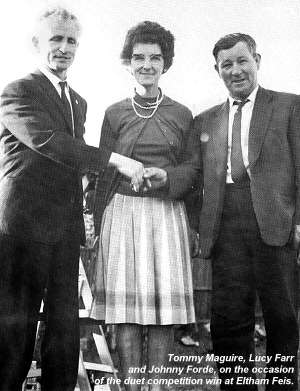 When her husband died in 1971, Lucy's sister Terry, now domiciled in the States with her husband Larry (originally from Abbey, next door to Ballinakill), invited her over and she went, with her daughter, Patsy, to New York.
When her husband died in 1971, Lucy's sister Terry, now domiciled in the States with her husband Larry (originally from Abbey, next door to Ballinakill), invited her over and she went, with her daughter, Patsy, to New York.
The following year she visited the first of three fleadhanna held in Listowel and it was there that she first encountered Peter Broderick, who had been one of her near unknown neighbours in Ballinakill. She was captivated by his relaxed way of playing and, once more, that strand of easy familiarity becomes apparent. It emerges yet again with Lucy's first meeting with the Keane sisters which, surprisingly perhaps, did not take place until 1978 at the National (English) Folk Festival at Loughborough. Lucy was entirely charmed by the sisters' generous nature and by the jaunty rhythms of their music. When asked up to play with them, there was a mixture of delight and panic in Lucy's mind, but Rita set her mind at rest when she opted for The Galway Rambler, a tune that Lucy knew well and one that has come to be associated with the Ballinakill Players. Later, Lucy visited the Keane family home at Tuam (Co Galway).
Loughrea visits continued unabated and led to contact with a still widening circle of musicians. She was now enjoying the benefits of tapes and records - sifting the music in all these contexts according to her own predilections. In 1984 she paid another visit to the States, this time to her son, Kevin, who was working in Nebraska. Travelling back via New York, she arrived at a concert being given by Aggie Whyte, the last encounter, as it turned out, before Aggie Whyte died.
Lucy moved out of London and down into Berkshire, near to her son, Brendan (always called Martin!) and has remained in this relatively musically bereft environment, enlivened by an occasional foray to a club, by correspondence between herself and friends and musical admirers, and a swapping of tapes. She celebrated her eightieth birthday with her family and a few friends in Thatcham. Her tape, Heart and Home, was brought out to coincide.
It is not just physical presence either: the matter may be pointed up by referring to Lucy' s liking for the music of Paddy Canny, a man whom she never met but heard on the old Shamrock label with P J Hayes and Peadar O' Loughlin, who made a distinct impression on her. It is Paddy's musical approach that counts. Lucy particularly admires the lift and rhythms of the music and plays, without hesitation, two of the three-reel set made popular, in part, by the record, namely The Tap Room and The Earl's Chair (both minor tunes). Perhaps the clearest example of how all this comes together occurred when Lucy visited Gurteen in 1974 and took a shine to the playing of Andy Davey. She loved the slow easy way that Andy rolled into his music - and she plays one of 'his' tunes on Heart and Home.
These examples of 'influence' say something, perhaps, about Lucy herself. She has often been unconfident about her own playing, although delighted when its qualities are appreciated. Thus, it is not surprising if sometimes, in a concentrated, potentially bewildering atmosphere such as, say, a teeming London scene might offer, she has felt a little lost. In a more free and easy world - that of Loughrea, say, Lucy feels that she has flourished. The individual attachments set out above underline this. No disrespect is implied, merely an acknowledgement of her own temperament. When you consider her way of playing, whatever influences there may have been, she sounds unique. The Ballinakill Players, whom you might expect to share at least some of her characteristics, employ far more embellishment. Lucy admits that she was never able to move the bow-arm well enough for sustained trebling. Listen, then, to Aggie Whyte and the proverbial chalk and cheese emerge. Straight away, it can be seen that Lucy cannot stand as representative of any 'Galway' style of playing.
That there are distinctions between musicians - fiddlers - is clear: the fierce, fairly short-bow application of the Donegal fiddlers; the long bow in West Clare; the ringing sound that comes in Kerry music; the way in which fiddlers from Leitrim often seem to leave some of their notes in the air, all this can be observed. Quite simply, though, Lucy does not sound like anyone else. She plays with a short to medium bowing action, often one stroke per note, and the fiddle tends to be held at a downward angle. Many a cheeky person has told her to sit up straight, without success, because the way she addresses the fiddle is the most comfortable for her. She also plays at the bottom end of the finger board which has the effect of softening the sound.
Her instincts are melodic but there are certain touches that modify this, in terms of embellishment, for example. In this respect, she does not play full rolls but relies on frequent grace-notes and a smooth triplet for effect. There is also a kind of flattened or half-note which helps to produce the 'lonesome' sound that Lucy feels is an essential part of her music, as it is also said to be for all the best fiddlers. It might be suspected that this flattening is not always planned but that the fingers are just not placed accurately on the fingerboard, especially in the upper registers. Heresy is not implied - the late John Kelly, for one, played in this way.
In reels, Lucy tends to play the eight quavers in a bar with equal emphasis, rather as if she were playing a concertina. There are no dotted rhythms. She usually plays each four or eight bar phrase in the same way, though a change of one or two notes then has a startling effect. 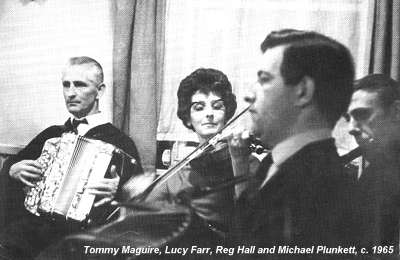 Overall, though, she does not use many variants. She likes to end certain phrases with two quavers and a crochet (diddle-dum) rather than with two crochets (da-da)! She will savour some long notes as ones which add character to a tune. There is often a drone effect as she hits more than one string - on Heart and Home this is particularly noticeable in her polka set - though this is not done in a consistent way, as it might be when pipes are being played. Her jigs are always played in a lively manner. Hornpipes tend to follow reels, in that dotted rhythms are not often prominent. How much of this is conscious, how much learned and, indeed, how much is the result of her growing older is not clear. Evidence of recordings from past years does indicate that she played in a stronger manner, but that the structure of tunes always seems to have been approached in the same way and the choice of embellishment is very consistent throughout her career.
Overall, though, she does not use many variants. She likes to end certain phrases with two quavers and a crochet (diddle-dum) rather than with two crochets (da-da)! She will savour some long notes as ones which add character to a tune. There is often a drone effect as she hits more than one string - on Heart and Home this is particularly noticeable in her polka set - though this is not done in a consistent way, as it might be when pipes are being played. Her jigs are always played in a lively manner. Hornpipes tend to follow reels, in that dotted rhythms are not often prominent. How much of this is conscious, how much learned and, indeed, how much is the result of her growing older is not clear. Evidence of recordings from past years does indicate that she played in a stronger manner, but that the structure of tunes always seems to have been approached in the same way and the choice of embellishment is very consistent throughout her career.
Another aspect of Lucy' s playing concerns the idea of a 'quare' tune, that which revolves around the 'lonesome' quality already mentioned. Such a tune is usually one with a minor sound, with root keys of A or E minor, less often B minor and sometimes D minor. G minor is rare. Paddy Fahy's most famous jig alternates between G and G minor and, as if to be perverse, Lucy plays a straight G version (so did Aggie Whyte, though the two versions are different). If there is no clearly minor mode involved then still Lucy flattens notes. For example, she naturalises the C#s in the first part of The Flowing Bowl whilst playing full C#s in the second part. The C# is, likewise, naturalised in the Round Polka on Heart and Home. The two untitled polkas on her cassette already mentioned have a 'logical' F# naturalised.
To pursue this a little further: the fling Mrs Dwyer, which Lucy only took on board in 1992, has an intriguing octave leap in its second part and an equally lovely, persistent bottom C, both of which appealed to her. (Incidentally, the learning of this tune shows that her ability to absorb new material is undiminished, despite protestations to the contrary.) She plays The Otter's Holt and Fred Finn's Reel in C when they are more often heard in B minor. The Fisherman's Lilt alternates between C and A minor. Lucy undoubtedly likes to hear that bottom string in all its possible richness: she plays Junior Crehan's Caislean an Oir (and the jig The Orphan) in E minor with a strong use of the bottom B note. Piquantly, she plays Junior's The Mist Covered Mountain in A minor; but enthuses over G minor versions.
It is appropriate to bring Junior's name into the reckoning. Readers may refer to Barry Taylor's article for a similar discussion, with both a musical 'analysis' and comments which illustrate, 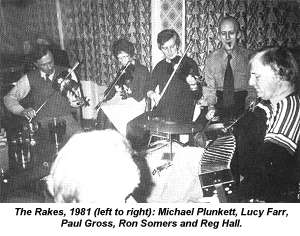 precisely, the 'lonesome' quality in Junior's playing which has been shared, amongst others, by Clancy, Casey, John Kelly and any number of players from Clare down to Martin Hayes (son of PJ). Plus, say, Tommy Peoples (acknowledging a wider relevance). And, of course, Lucy herself. The whole subject is fascinating for any study of Irish music.
precisely, the 'lonesome' quality in Junior's playing which has been shared, amongst others, by Clancy, Casey, John Kelly and any number of players from Clare down to Martin Hayes (son of PJ). Plus, say, Tommy Peoples (acknowledging a wider relevance). And, of course, Lucy herself. The whole subject is fascinating for any study of Irish music.
It is also important to note the speeds at which tunes are played, and not just those where this 'lonesome' quality is evident. It is one thing to bounce along as for dancing, quite another to mull over a tune in a wholly quieter context and manner. Such reflective communing is very much a part of Lucy's playing, enabling the listener to savour and to contemplate and respond to the particular beauty - the nobility, as John Kelly put it - of a tune . A number of players to whom Lucy will pay tribute play in this way - the clearest example being Andy Davey. 'His' tune on Heart and Home, confined as it is to a limited spectrum, has these possibilities.
Obviously, art music patterns are used here as a means of description, rather than as definitive explanations of Lucy's playing. The character of minor tunes, though (if conventional terms may be pursued), is clearly important in the discussion. It would be easy to get sentimental and to talk about melancholy and gnashing and wailing. There may well be a touch of romance involved but it is never out of hand. In any case, if music does not move a body, why bother? To invoke the marriage of heart and head, therefore, is not misleading but is to underline, exactly, what constitutes musical intelligence.
Whatever comments are made about Lucy's playing - and this complex approach is a strong element, but not the only one - it is timing which counts above almost everything else: pace and rhythm and a 'where and when' in any tune. This is the quality that Lucy admires most about other players and her conversation will return to this aspect again and again. Playing along with her, with this in mind, is, as might be expected, an education in itself. Mere cleverness, again as you might expect, is unacceptable. Ultimately, we are looking, perhaps, at a highly refined sense of the inner space in music and a way of feeling which, at risk of labouring the point, has come from a shared approach to music born in a tight-knit community of musical appreciation. Given life, it is true, by individual accomplishment but, essentially, a superb example of how traditional music is transmitted.
Such considerations came to mind frequently when Heart and Home was mooted. We tried, first, to follow a roughly chronological pattern, beginning in Ballinakill, but Lucy simply could not remember what had been played during her youngest days except in snatches. She did, however, recall the very first tunes that she ever consciously learned - Old Man Dillon and A Mug of Brown Ale - in simple, direct settings which rely on impulse and vigour for effect. The Collier's Reel has already been mentioned and, while Lucy suggests that reels were not so common in the total repertoire of her young days as they seem to be now, she did remember Miss McLeod and The Morning Star as favourites. Again, although she tended to leave alone those tunes which have come to be associated with this or that musician, as having had sufficient exposure, she did offer the delightful reel set, Colonel Frazer and The Foxhunter's, both in two-part settings, which the Ballinakill Players recorded. She has subsequently prolonged the connection with Ah Surely (always called Killibegs House), a couple of untitled reels and a hornpipe, and of course, The Carraroe Jig.
In the same way, tunes linked to Tommy Whelan have been revived: the reel named after him, plus Delaney's Jig (which Breathnach calls Port Tineatha in Ceol Rince, 1) and the curiously-named Retch Her on the Harrowpins. A number of nights spent going through a barrage of 'old-fashioned' tunes reminded Lucy that she and Jim Moloney often played Tim Moloney together (no relation, as far as is known); and she was delighted to come across Paddy's Gone to France again (one of a number of names) and the tune which Breathnach got from Sonny Brogan and names Eilis no Bhrogain, which Lucy will often play in a session. Jigs like The Lark on the Strand, The Rose in the Heather and The Cook in the Kitchen have enjoyed their own revival. No doubt, in the right company, many more tunes would emerge.
It seems abundantly clear, in this respect, just why sessions are so important to players as catalysts for extricating tunes from the memory, especially since it becomes possible to glimpse the extraordinary numbers that exist there.
The point can be illustrated: Lucy's father's march (on Heart and Home) did not surface until 1974 when Lucy was visiting Loughrea. Then, in her sister's kitchen, it was Sonny Clarke, one-time neighbour, who reminded the company by beginning to lilt the tune. Together, mainly through Lucy's sister's efforts, those present put the tune back together. In contrast, Slieve Aughty just came to mind recently in the course of a night's playing and talking but, in this case, fully formed. Lucy thinks that it might have been composed by the Father Kelly of Father Kelly's Reel and that Aggie Whyte might have been responsible for putting it into circulation. Sonny Comer's Fling came to light in the same way as Slieve Aughty and it is interesting that Lucy is clear in her mind that the pace at which she plays it is the pace at which it was played in Ballinakill; contrast the Coen Brothers on The Branch Line (Topic 12TS337; 1977). 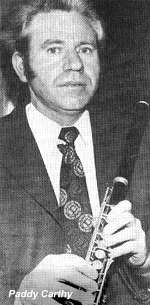 To Lucy's regret, the flings on Heart and Home, together with Maggie Pickens and Love, Will You Marry Me?, are the only ones that she can remember as indicating a much more extensive repertoire of one of her favourite measures. On the other hand, she does have a substantial number of single jigs at hand. (To the listener, it is curious how so many musicians put together a single and a double jig without distinguishing the measures, whereas the beat, once attention is paid to it, does reflect a particular way of stepping.)
To Lucy's regret, the flings on Heart and Home, together with Maggie Pickens and Love, Will You Marry Me?, are the only ones that she can remember as indicating a much more extensive repertoire of one of her favourite measures. On the other hand, she does have a substantial number of single jigs at hand. (To the listener, it is curious how so many musicians put together a single and a double jig without distinguishing the measures, whereas the beat, once attention is paid to it, does reflect a particular way of stepping.)
Once the Ballinakill days had been temporarily exhausted as a potential source for Heart and Home, it was tunes associated with particular musicians down the years which have become prominent in ways noted earlier. Casey's Farewell to Connaught is an example, to which Lucy herself added The Maids of Mitchelstown. That introduces us to another aspect of her playing. Normally, she will play a tune singly as was the custom when she was young. When there is a coupling, much experience has gone into the choice. Lucy could not necessarily explain why such a tune is appropriate but, once accepted, the coupling tends to stick. She put The Hunter's Purse and The Hare's Paw together, for instance, much to the delight of the Loughrea crowd. Obviously, others elsewhere may have done the same.
When discussing and playing Casey's The Drunken Gauger Lucy said how much she liked the poignant way that Bobby eased his way into the first B note. Such pinpointing - she will often say, "That note is alien" - she feels comes from her father. It is what is meant by 'experience' and can, of course, be challenged, but is exactly what marks out the individuality of a musician. As a gloss on this, it is worth remarking the way in which Delaney's Jig has been addressed recently. Lucy heard the tune but simply could not play certain runs as she was hearing them. Gradually, she came up with a version which she now believes to be based on how she might have heard it some 60 years ago. It became equally clear that the patterns of notes that she kept substituting were absolutely ingrained, bordering on 'stock'. In a way, this sums up much of what has been said. Take yet another facet: listeners to Heart and Home may note how Lucy ends McFaddyen's Reel on the first part so as to round it off. In a session, she will play the tune now called Eddie Moloney's Reel - Lucy names it for Paddy Doorey - with The Swallow and finishes the latter with its first part for the same reason.
You cannot escape the influence of Loughrea in all this. So many of the associations that Lucy brings to mind seem to date from 1965 and the years following when she was, perhaps, most active in travelling and gathering music. Thus, Pat Burke's Jig came from a record of his son, the one and only Joe, around then. The Fisherman's Lilt, another Casey tune, hails from the same period. McGovern's came through the twin legacies of Andy Davey and Dan Collins (brother of Kathleen and domiciled in the States), again in sessions at this time. The Pullet and The Cock, McFaddyen's, Bonaparte ... and Frank Downey's Hornpipe (all on Heart and Home) date from these years. Incidentally, Lucy explains that Frank played his tune (and others) after a session, in a quiet moment, and that the way he played it suggested a hornpipe rhythm, but that she would be perfectly willing to accept that it is probably a slowed-down reel.
There are two Fahy tunes on the cassette, a jig and a reel, both rather more conventional than a lot of Paddy's, and Lucy has remarked that the run of phrases, despite the different time-signatures, is quite similar. In sessions with Lucy, any number of Fahy tunes will be flying around, and perhaps even more from Paddy Carthy. Lucy's experience of playing with Fahy, Carthy, et al, whilst not seminal, was especially influential. Lucy will play Dunmore Lasses, The Flower of the Flock and Queen of the Fair in settings which owe much to Loughrea musicians. There are two particularly nice single jigs that come from John Joe Forde. Johnny's Wedding can be associated with playing in Loughrea, though here the initial stimulus was revised in the light of young Paddy O' Brien's playing (Offaly, as opposed to old Paddy O' Brien, Tipperary). Both box players receive Lucy's admiration and she still plays a number of old Paddy's tunes. Young Paddy - not so young now; one must always take into consideration Lucy's longevity - is one of those 'recent' musicians who get the plaudits, though Lucy is not really interested in the invidious league-tabling of musicians. She is more concerned with illuminating the careers of lesser-known musicians of her acquaintance, the unsung heroes and heroines who push traditions along, the Paddy Dooreys and Maureen Minogues of the world.
Two sets of jigs on Lucy's cassette come from Packie Byrne, one named after him, the other The Stepping Stones and McShane's Rambles. Lucy chose them because they were relatively unknown and, especially, because of the 'lonesome' sound of the untitled set. They represent occasions when she has teamed up with younger musicians, in this case, Sharon Creasy (flute), and it is important to record this aspect of Lucy's career. John Naughton's and John P Blessing's appear to have come via Sharon, again from Packie Byrne, although both appear in the pages of Treoir, sometimes a valuable source of printed material. (John P himself was playing wonderfully on a 1992 programme in the RTÉ series The Pure Drop) In this collaboration between Lucy and younger players mention must also be made of the late Chris Ferguson (flute) with whom Lucy shared many happy hours. The tradition continues - she is extremely generous with her time and attention.
Another source for Lucy was O' Neill's, particularly during those early days in England when she sat for hours poring over 'the Book' and worked away in particular at a number of set dances, The Humours of Bandon and The Orange Rogue among them. She feels that it is a pity tunes like these are not given an airing in sessions, being thought of as dull; thankfully, she has restored Hurry the Jug and Johnny Cope, at least, to her current repertoire. Of course, the 'standards' appear from time to time - Rakish Paddy, The Shaskeen, The Star of Munster, The Ships Are Sailing, Whelan 's Jig, Pound Hill, The Liffey Banks and so on. 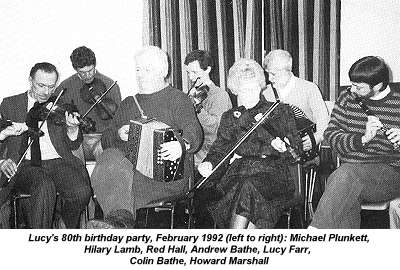 It would be safe to say that Lucy has a vast number of these tucked away. Often, they emerge with just a tiny touch of individuality, as for example, recently, The Chicago Reel. These tiny adjustments, like many of the aspects of Lucy's playing noted above, may not, in themselves, be so very original (Lucy will, naturally, admit that) but, collectively, are just the thing to make traditions tick along.
It would be safe to say that Lucy has a vast number of these tucked away. Often, they emerge with just a tiny touch of individuality, as for example, recently, The Chicago Reel. These tiny adjustments, like many of the aspects of Lucy's playing noted above, may not, in themselves, be so very original (Lucy will, naturally, admit that) but, collectively, are just the thing to make traditions tick along.
It has been the intention here, to give a flavour of Lucy's more uncommon tunes and it is hoped that the multiple character of sources has been fairly represented. At the same time, the immersion in tradition and the impulse that Lucy has given is no mean feat and must be diligently valued. It has, of course, been difficult to pin down dates and, often, exact circumstances. Lucy cannot, in all conscience, recall all that she might wish to. And she will agree that many, many more musicians could set out a similar story. So that, in conclusion, you cannot simply sum up a musician. You will instead marvel. You do not demean by 'placing' - Lucy's whole history is ample demonstration of this. Instead, you accept differences and are grateful. And achievements might best be marked not by fame and fortune but in the way that your own perceptions have been changed for ever. Lucy's musical career, filled with generosity and patience, allows entrance to what, after all, is a most privileged world of imagination, quality, humour, musical kinship, social grace - all those manifestations of humanity liberated by the word, traditional. Heart and Home is a title meant to encapsulate some of this experience, not just as it might apply to Ballinakill and Ireland (for, after all, Lucy has lived in England for over fifty years) but to the music that gives life and colour wherever and whenever it is played.
Reg Hall kindly helped with dates, especially in the second part. Opinions throughout, and particularly in the third section, are the responsibility of the author.
Roly Brown
Article MT104
| Top of page | Home Page | Articles | Reviews | News | Map |